Quick Lure Facts
- Fishing lures are designed to represent fish prey and used as artificial bait to catch fish.
- We are less likely to catch fish that feed on weed and algae using lures. Lures attract predatory fish that eat other fish and living creatures.
- At Camping Australia we categorised our lures as hard body, soft plastic, jigs, metal, spinnerbaits and game lures.
- Lures are designed to cater for certain areas, applications in fresh and salt water and target species. It is essential that we gain a substantial knowledge so you can locate suitable product for their specific application.
Spinnerbaits
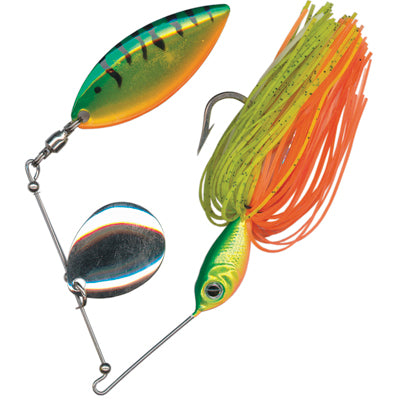
Spinnerbaits are based on a wire frame shaped like a ‘V’ with a tow point at the pointed end where the line is attached. One arm has blades attached that spin and wobble providing flash and vibration to attract fish. The other arm has a lead head jig with hook attached and a rubber skirt attached to attract the fish to bite.
Spinnerbaits are extremely popular in freshwater for Bass, Yellowbelly, Sooty Grunter and Saratoga. They can be fished vertically against a rock wall, tree or weed bed as the blades helicopter, as the lure drops to the bottom, and fish will bite the lure on “the drop” (as it sinks).
Spinnerbaits are also extremely snag resistant as the top wire and blades protect the hook from snagging. This makes them ideal for fishing around submerged timber and weed beds. A stinger hook can be attached to assist with hooking fish, however this does decrease the snag resistance of the lure. The stinger hook is attached the same way you link hooks in a gang rig, eye to bend. One popular stinger hook is the Gamakatsu Siwash (labelled Stinger Hook).
A variety of weights are available allowing different depths to be fished. They can be cast and retrieved or slow trolled. Colarado, rounder, blades allow the lure to work slower and provide maximum vibration which is good in dirty water. Willow, narrower, blades allow the lure to run deeper but require a faster retrieve to make the blades spin. Most spinnerbaits utilise one of each blade to satisfy both needs.
Popular colours to start with include Purple, Bony Bream and Brown / Gold.
Spinners
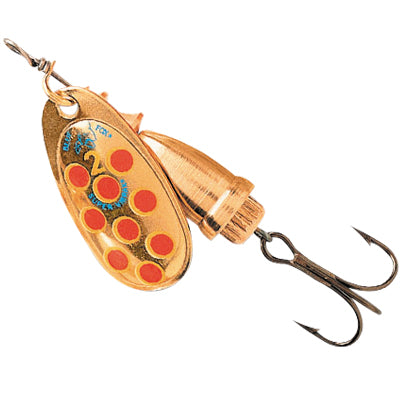
Spinners are sometimes referred to as in-line spinners because of their design. They have similar fish attracting qualities to a spinnerbait, flash and vibration, but are designed on a single piece of wire with a loop at one end to attach your line, a blade that spins around the centre wire, some sort of bulk in the body section and a hook attached at the rear of the wire.
Spinners are relatively inexpensive and available in a wide range of sizes, colours and styles. They are popular for freshwater species including Trout, Bass and yellowbelly.
Metal Lures

Metal lures are designed to represent a fleeing baitfish and like baitfish come in a wide variety of colours, sizes and shapes. By retrieving these lures at high speed we trigger the predatory instinct in fish such as Tailor, Trevally, Tuna, Mackerel and Queenfish. It is important to ‘match the hatch’, which means selecting a metal lure of similar size to the baitfish on which the predatory fish are feeding.
Metal lures come in a variety of styles. As an example within the Surecatch range we have three models that fill different roles. The Bishop is a metal ‘slug’ with little action that is designed to be retrieved flat out. The Knight is a metal ‘slug’ with more swimming action built into the shape of the lure allowing a medium to fast retrieve. Finally the Rook is a metal ‘spoon’ meaning it is flatter in shape, like a spoon, which has a lot of action built into the lures shape. This allows it to ‘work’ at slower speeds and is an effective lure for slow trolling.
Metal lures can also be jigged, which involves dropping the lure toward the bottom and jigging the lure aggressively while retrieving it toward the surface.
Trolling / Barra Spoons
Trolling Spoons have been catching fish for decades. Simple in design they consist of a metal spoon with a large single hook bolted onto the spoon. They are simple, tough
and when slow trolled, have a seductive trolling action that Mackerel and other pelagic species cannot resist. They are still enormously popular among yachts and cruises that troll as they travel, catching more fish than many other types of lures.
Soft Plastics

Soft plastics come in a wide variety of sizes, styles and colours, with a soft plastic lure to suit almost any fishing application. The fact that these lures are soft and chewy when fish bite them means they are more likely to bite them more than once and hold onto them longer than a hard lure. The fact that these lures are soft also means that little movement is required to impart action into the lure and therefore they can be fished extremely slowly. When choosing a soft plastic it is important to ‘match the hatch’, selecting a soft plastic that is similar in size, colour and shape to what the fish are feeding on. Soft plastics can be rigged unweighted or on a jighead. Jigheads come in a wide variety of hook sizes and weights. The hook size and weight needs to be matched to your fishing application. Soft Plastics have become extremely popular and a good place to start is 2-3” plastics for Bream and 3-4” plastics for Flathead and Bass. Jigheads are also available that are resistant to weed and snagging, or have spinning blades attached for added attraction. Some colours to start with include pink, chartreuse, watermelon, white and natural baitfish colours in the saltwater and pumpkin, purple, baby bass, rainbow trout, browns and greens in the fresh.
Surface Lures
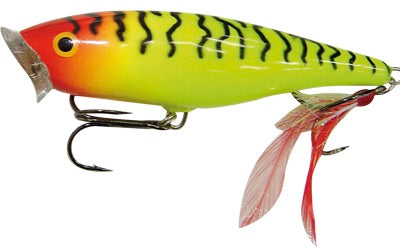
Fishing surface lures is a visual and heart stopping way to fish. Sub surface lure fishing means that all the action takes place below the surface of the water, but by fishing lures on the surface, the angler encourages explosive surface takes and highly visual fishing.
Freshwater
Sliders, pushes and poppers are designed to work in the surface film. Sliders are the most subtle moving across the surface, pushes creating a larger bow wave in front of the lure and poppers creating the most disturbance spitting water off their cupped face and creating an audible popping sound.
Walkers have a wide bib across the front of the lure causing it to waddle from side to side when retrieved. This creates a large surface disturbance and noise which may represent a mouse, small bat, lizard or frog trying to find a bank to escape the water.
Fizzers have small propellers on the lure that make a buzzing or fizzing noise as the lure is retrieved across the surface. This represents an insect that has landed in the water and is struggling to take off again.
Surface lures are extremely effective when fished in the low light conditions of early
morning, afternoon and into the night. They are extremely effective fished around structure, including banks, overhanging vegetation, submerged timber and weed beds where fish wait for food and prey may fall into the water. Popular retrieval methods include a slow continual twitching retrieve or a stop start retrieve with lots of pauses. Another popular method is to cast the lure out and let it sit till all the rings created by the disturbance of the lure landing have disappeared. The lure is then moved a short distance allowed to rest again and the process repeated. It can take a couple of minutes to retrieve each cast, but is an extremely effective and exciting method.
Warmer months, when there is more insect activity are the most effective times to fish surface lures. Your aim being to retrieve the lure in a way that represents an insect or animal trying to make its way to the safety of the bank.
Saltwater
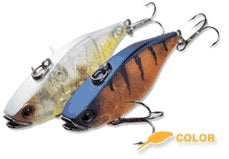
The above methods will work in saltwater and are used mainly for chasing bream. However in saltwater the most popular use of surface lures involves the high speed retrieve of large poppers for Mackerel, Trevally and other larger predatory fish. These larger poppers represent a fleeing baitfish, such as a Gar, and trigger the predatory instincts of these larger fish.
Lipless Crankbait
Lipless crankbaits are a narrow, herring shaped lure with the tow point mounted on the top of the lure. They are a sinking lure that when retrieved vibrate rapidly. Larger models are trolled in the saltwater for pelagic fish. Smaller models are cast and retrieved stop start in the salt and fresh. Being a sinking lure they can be fished vertically around timber, snags, rock walls and in deep holes. They are popular for fishing snags and rock bars for Mangrove Jack, Cod and Barramundi in North Qld and Bass in the freshwater dams. They are available with loud rattles built in as an added fish attractant.
Deep Water Jigs
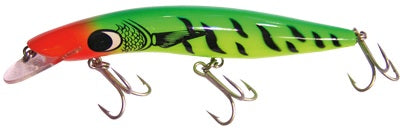
Deep Water Jigs are large metal lures that are dropped toward the bottom in offshore waters and retrieved in a rapid lift and drop jigging motion. These lures represent fleeing, injured baitfish and are a favourite of large predatory fish including Amberjack and Kingfish, with many varieties of reef fish also caught on these lures. The hook used is a jig assist hook which is attached separately via a built in, braided loop. The hook is often attached to the top of the lure so that when a fish is hooked the angler has direct contact with the fish rather than fighting it through a lure that may weigh half a kilo or more. Having the hook at the top also provides less opportunity for it snag when dropped to the bottom in reef areas.
Hard Bodied Lures
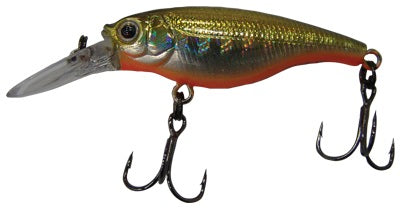
Hard Bodied lures are so named because they are generally made from timber or injection moulded plastic. They come in a wide range of sizes from 3-5cm models for Trout, Flathead and Bream through to 25cm monsters used for trolling for mackerel. Hard Bodied lures often feature a clear plastic bib at the front of the lure which causes the lure to dive as water pressure pushes against the bib when retrieved. Different shaped and size bibs will cause the lure to dive to different depths often described on the packaging as +3m or +5m (meaning 5m or more). Popular colours for estuary fishing include pink, green and natural baitfish colours. Popular offshore colours include blue pilchard and white with a red head.
Game Lures

Skirted Trolling lures are designed to be trolled (towed) by boats when fishing offshore. They are basically a head and skirt designed to skip across the surface or just below the surface creating a disturbance which attracts predatory fish. A heavy leader is threaded through the front of the lure and a large hook or hooks attached. They are commonly used for chasing marlin, sailfish, tuna, dolphin fish and mackerel. They come in a range of sizes and colours depending upon the area you are fishing and the species being targeted.
Squid Jigs

Squid jigging takes place during the day and at night, with bright over-head lights to attract the squid.
Squid feed mainly on fish and prawns hence the reason for prawn shaped jigs being such a popular lure.
A float is often used on the squid line so that that squidding can commence as soon as the angler arrives at the fishing location. This may enable the angler to catch a squid or two while fishing, to top-up their bait supply or to prepare for a tasty meal.
Once squid come around, it is useful to keep the jig moving in the water – in a manner that imitates an injured prawn or fish. This is usually done by simply lifting the line, pulling in the slack, jerking once again and so on, until the jig is back to the surface. The jig is then cast and allowed to sink to the desired depth, and the same jerking motion is repeated over again.
As soon as a squid grabs the jig and the line tightens, let the squid take it for a minute or so to ensure it has a good grip on the jig. It is then we strike firmly to set the hooks and then slowly and steadily wind the squid in. It’s important not to let the line go slack whilst retrieving as the squid may get off.
Squid squirt a cloud of black ink into the water to hide them while they escape from prey. It is a good idea to encourage them to empty their ink sacs before bringing them on board or ashore by gently jerking the line as you pull them in.
A landing net is a useful piece of equipment when squidding. This is to help lift the squid into the boat gently which minimises the risk of escape after a tentacle breaks.
Squid is often referred to by its Italian name, ‘Calamari’.

Leave a comment: